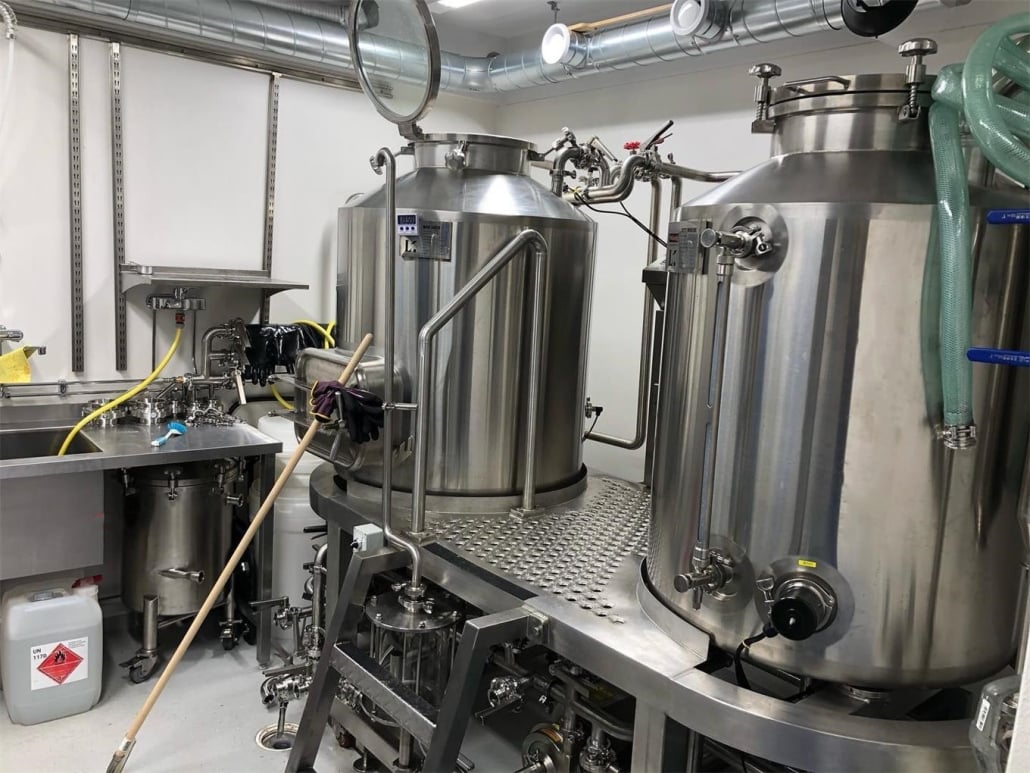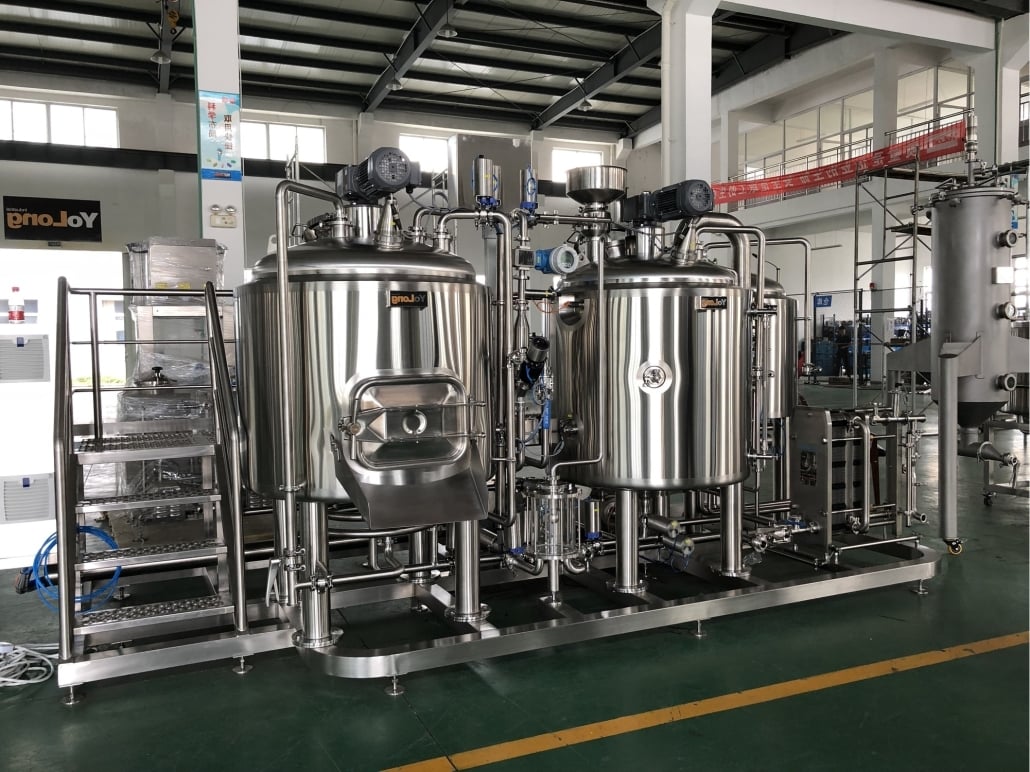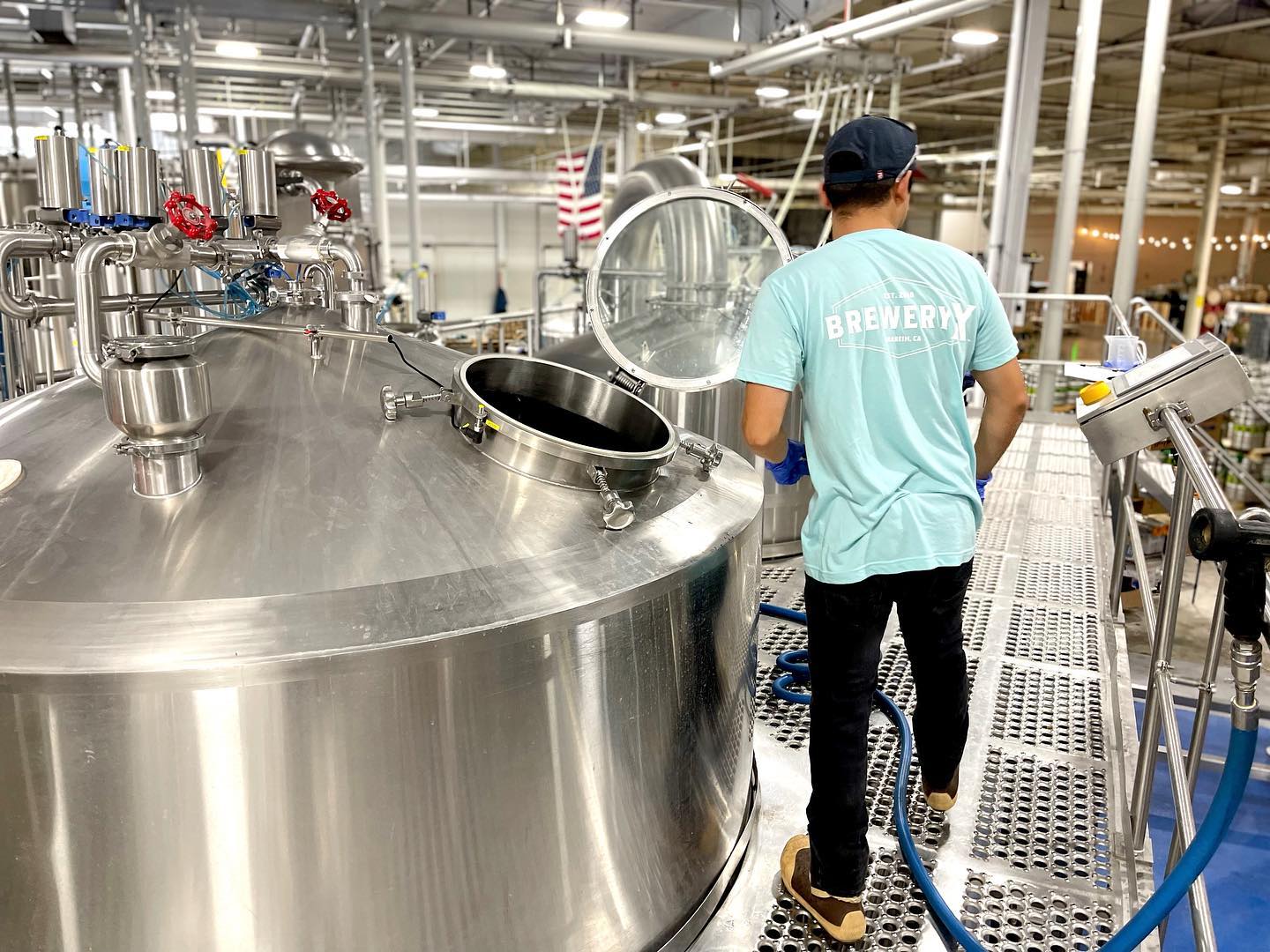The brewing advantages of 2 BBL Brewing Equipment
2 BBL Brewing Equipment refers to the system and components needed to brew 2 barrels or about 62 gallons of beer at a time. This size is common for microbreweries and craft breweries looking to produce beer on a small commercial scale.
A complete 2 BBL brewhouse allows control over the full brewing process from mashing to fermentation. Key components include the mash tun, brew kettle, whirlpool, heat exchange, fermenters, brite tanks, and other supporting infrastructure. beyond the standard equipment, breweries can customize and scale up or down to fit their production goals.
When selecting a 2 BBL system, brewers evaluate size, efficiency, degree of automation, layout, price, supplier services, and more to find the ideal configuration for their needs. This guide covers the end-to-end considerations for 2 BBL brewing.

2 BBL Brewing Equipment Guide
This section explains the function and options for the major components in a 2 BBL Brewing Equipment.
Mash Tun
The mash tun mixes milled grains with hot water to extract sugars, proteins, and flavors that will carry through to the final beer. Design choices impact efficiency, quality, and labor time.
| Type | Description |
|---|---|
| Infusion mash tun | Well-insulated stationary tun with screens and rakes to facilitate infusion mashing |
| Lauter tun | Separate external tun used after the mash to lauter (clarify) the wort |
Brew Kettle
The brew kettle (or coppers) boils the sugary wort, allowing adjustments to hop additions and concentration. Kettle design affects efficiency, ease of use, and options for automation.
| Type | Description |
|---|---|
| Direct fire | Heated underneath by gas or steam burners |
| Indirect heat | Heated externally by steam jackets or heating coils |
| Electric | Heated by electrical elements with variable power |
Whirlpool
Whirlpools use centrifugal motion to separate solids from newly boiled wort before transferring to the fermenter. This clarifies the liquid and enhances flavor.
| Type | Description |
|---|---|
| External whirlpool | Separate tank that accepts transfer from the kettle |
| Internal whirlpool jackets | Cyclones inside the kettle create whirlpool motion |
Heat Exchanger
A compact heat exchanger rapidly cools the hot wort to prepare it for yeast pitching and primary fermentation. Achieving the right temperature is critical.
| Type | Description |
|---|---|
| Plate heat exchanger | Thin plates transfer heat for rapid cooling |
| Shell and tube heat exchanger | Tubes contain wort surrounded by coolant |
Fermenters and Bright Tanks
Primary fermentation, conditioning, carbonating, and storage require temperature-controlled stainless steel vessels supporting yeast health. 2 BBL configurations have multiple 2 BBL fermenters and bright tanks.
| Type | Description |
|---|---|
| Uni-tank | Combined fermenter and brite tank in one |
| Cylindrical | Traditional cylindrical fermenter design |
| Conical bottom | Allows sedimentation of yeast and hops |
2 BBL Brewing Equipment by Supplier
Many brewhouse engineering companies offer configurable 2 BBL systems. Prices vary based on materials, automation, and customization.
| Supplier | Base Price Range | Description |
|---|---|---|
| Specific Mechanical | $100,000 – $250,000 | Custom US-made brewhouses with modular options |
| Craftwerk | $150,000 – $200,000 | German-made stainless steel brew houses emphasize precision |
| Premier Stainless | $75,000 – $150,000 | Range of imported Asian systems at lower budget |
| Portland Kettleworks | $140,000 – $190,000 | American-made systems focus on welded sanitary construction |
| Stout Tanks | $90,000 – $160,000 | Highly configurable Chinese import systems |
The Brewing Process with 2 BBL Brewing Equipment
While exact configurations vary, the basics of beer production utilize the following process flow through 2 BBL equipment:
- Measure out and mill malt grains according to the recipe
- Transfer grain and 170°F water to mash tun to soak and extract sugars and flavors
- Recirculate the wort during mashing for even mixing and conversion
- Sparge additional hot water rinse through grain bed to extract remaining sugars
- Transfer wort to the brew kettle and bring to a boil
- Add hops at points during the 60-90 minute boil per recipe targets
- Create whirlpool motion to clarify and settle solids the bottom when boil is complete
- Rapidly cool boiled wort using a heat exchanger down to 55-65°F for fermentation
- Transfer cooled wort into primary fermenter along with yeast
- Allow approximately 1-2 weeks primary fermentation at ideal yeast temperatures
- Transfer fermented “green” beer to conditioning tanks and allow yeast to settle and mature flavors
- Optionally transfer to brite tank for clarification, carbonation, and final aging prior to packaging
- Package beer into kegs, cans, or bottles with desired carbonation levels
Planning Your 2 BBL Brewery Layout and Flow
An efficient layout allows easy movement of ingredients through the brewhouse and into fermentation, while keeping cleaning routes short. Typical options:
| Layout | Description |
|---|---|
| Linear process flow | Straight line equipment layout from start to finish |
| Compact footprint | Stacked vertical layout or consolidated design |
| Custom shapes | Unique layouts to fit the space |
General principles for 2 BBL brewhouse layout:
- Position mash tun close to mill room at same level
- Place brew kettle lower to allow gravity transfers
- Locate heat exchanger above fermenters for transfers
- Keep similar process steps together in “zones”
- Design self-draining floors with adequate drains
- Allow room for storing grain, packaging materials, etc.
- Factor in space for cleaning tanks, tools, hoses, pumps
- Accommodate adjustable fermentation tank stands
- Allow for future expansion as needed
Many engineering firms provide free consultations and 3D layout modeling as part of system quotes.
Customization Options for 2 BBL Brewing Equipment
While turnkey systems meet basic needs, further customization allows unique capabilities:
| Area | Customization Options |
|---|---|
| Automation | Computerized system control, automated tank transfers and cleaning, integrated sensors |
| Brewing | Additional vessels for souring, fruit additions, etc. Upgraded kettles and tuns for alternate mashing styles |
| Fermentation | More tanks, variable pressure units, custom glycol chilling, hybrid uni-tanks |
| Packaging | Integrated canning or bottling lines, keg washers, counters |
| Layout | Multi-level designs, specific room buildouts, raised platforms |
| Exterior | Branding, logos, custom colors and materials |
| Safety | Alarm systems, spill containment, ventilation, spark proof equipment |
| Sustainability | Heat reclamation, solar power, energy-efficient vessels |
Custom options increase cost but enable specialty recipes, higher efficiency, less labor, tailored spaces, and unique branding.
Selecting 2 BBL Brewing Equipment Suppliers
With many equipment options, choosing the right partner involves balancing factors like cost, quality, and services.
| Consideration | Description |
|---|---|
| Brand reputation | Look for track record of high-quality brewhouses suits to style and budget |
| Construction | Fully welded and polished sanitary stainless steel interiors using quality grade material |
| Sizing | Standard vs custom sizing for each vessel and rooms |
| Automation | Degree of automated control system vs manual operation |
| Efficiency | Thermal insulation, precise temperature control, circulation for mash and boil efficiency |
| Options | Wide range of à la carte customization and add-ons |
| Lead time | Typical range is 12-20 weeks from order to delivery |
| Services | Design consultation, layout planning, shipment, installation assistance |
| Terms | Flexible 50% down payment plans available, leased financing |
| Location | Domestic provides easier support while imports offer lower budget options |
Ideally find the optimal intersection of quality, configurability, and services for brewing goals. Get quotes from multiple vendors.
Comparing Pros and Cons of 2 BBL Brewing Equipment
Like any purchase, brewhouse systems involve tradeoffs to balance.
Pros:
- Flexible size for small batch craft recipes
- Lower capital investment than larger systems
- Simpler requirements for floor space, energy, labor
- Potential for hands-on traditional techniques
- Allows room to grow production over time
Cons:
- Lower efficiency compared to bigger automated systems
- More manual work per volume of beer
- Limited packaging line speeds (cans, bottles, kegs)
- Tighter margins with higher ingredient costs per barrel
- Requires care to ensure consistency between small batches
The scale of 2 BBL strikes a balance for many starting craft brewers. It allows adequate output for a taproom while remaining small enough for artisan methods.

FAQ
What size space is needed for a 2 BBL brewhouse?
- Approximately 1,000 to 1,500 sq ft for all equipment, fermentation area, storage, and work space. The specific footprint depends on layout efficiency and options chosen.
What are estimated operating costs and margins?
- Ingredient costs around $100-150 per barrel, $10-15 per case. Operating costs including labor, utilities, etc. around $4-8 per case. Target selling for $25-35 per case allows healthy margins.
How much output can a 2 BBL system produce annually?
- Approximately 250 barrels or 7,700 cases per year if brewing weekly. This allows supplying a moderate taproom business. Larger brewpubs may utilize multiple 2 BBL systems in parallel.
What are typical consumables and maintenance on a 2 BBL brewhouse?
- Replacement gaskets, hoses, pumps every 2-3 years. Annual calibration of sensors and valves. Cleaners and lubricants with each cycle. Periodic replacement of worn/damaged parts.
What expertise is needed to operate a 2 BBL system?
- Homebrewing experience is useful background. 1-2 trained brewers can fully operate the system. External brewing courses are recommended. Some automation reduces labor needs.
How long do 2 BBL brewing systems last?
- With routine care and maintenance, vessels and parts typically last 10-15 years in full production. Refurbishing the system can extend its useful life as well.
Can 2 BBL systems package beer in cans?
- Yes, manual or semi-automatic canning lines sized for 2 barrels output are available. Cans require an additional equipment investment but allow portability.
Additional FAQs About 2 BBL Brewing Equipment
1) What utilities do I need to run a 2 BBL system reliably?
- Plan for 208–240V power (single or three-phase depending on electric loads), natural gas/propane if direct-fire or a small low-pressure steam boiler if jacketed, 20–40 gpm potable water supply, floor drains with adequate slope, and a glycol chiller sized for peak fermentation plus crash loads.
2) How big should my glycol chiller be for a 2 BBL cellar?
- Rule of thumb: 1.0–1.5 refrigeration tons per actively fermenting 2 BBL tank, plus headroom for crashing and brite cooling. For three 2 BBL unitanks, many breweries spec 3–5 tons total, depending on ambient and usage.
3) Can a 2 BBL brewhouse support double-batching into larger fermenters?
- Yes. Many operators double-batch into a 4 BBL or 5 BBL FV to maximize tank turns. Ensure your hot liquor capacity and heat exchanger can handle back-to-back runs and that your platform and pumps are sized accordingly.
4) What brewhouse efficiency should I expect at 2 BBL scale?
- Typical mash/lauter efficiency ranges 70–82% with consistent milling, pH 5.2–5.6, and controlled sparge flow. Dial-in over 5–10 brews; small variances have a bigger percent impact at this scale.
5) Is “automation-lite” worth it on 2 BBL systems?
- Usually yes. Step mash controls, timed hop additions, HLT setpoint automation, and basic data logging improve repeatability and reduce labor without the cost of full PLC integration.
2025 Industry Trends: 2 BBL Brewing Equipment
- Lead times stabilize: Standard 2 BBL brewhouses ship in 8–12 weeks; custom automation or steam skids: 12–16 weeks.
- Automation-lite: Cloud logging, recipe steps, and remote alerts are mainstream sub-$4k add-ons.
- Energy savings: Wider adoption of insulated kettles, heat recovery (wort vapor condensers), and variable-speed pumps; brewhouse energy reductions of 10–20% reported.
- Quality instrumentation: Inline DO at knockout and sample ports on unitanks increasingly standard, improving shelf stability for to-go packaging.
- Small CO2 recovery pilots: Micro-CCS skids sized for 1–5 BBL batches are emerging, reducing purchased CO2 for busy brewpubs.
2025 Benchmarks for 2 BBL Systems (North America/EU)
| Metric | 2023 Avg | 2024 Avg | 2025 YTD | Notes/Sources |
|---|---|---|---|---|
| Turnkey 2 BBL 2-vessel brewhouse (installed) | $85k–$150k | $80k–$145k | $78k–$140k | Vendor quotes; options vary |
| Typical lead time (weeks) | 12–18 | 10–14 | 8–12 | Supply chain normalization |
| Electric kettle demand (kW) | 24–36 | 22–34 | 20–32 | Better insulation/elements |
| Brewhouse efficiency | 70–80% | 71–81% | 72–82% | Training + mill control |
| Water use (hl water/hl beer) | 7.0–8.5 | 6.0–7.5 | 5.0–6.5 | With CIP reuse, HR |
| Cloud/IoT controls adoption | 18% | 29% | 44% | Controller OEM data |
Authoritative resources:
- Brewers Association benchmarking, sustainability, and quality: https://www.brewersassociation.org/
- Master Brewers Association Technical Quarterly (process/CIP/QA): https://www.mbaa.com/publications/tq/Pages/default.aspx
- IBD Knowledge Centre (brewhouse/cellar design): https://www.ibd.org.uk/
- US DOE Better Buildings (food & beverage energy): https://betterbuildingssolutioncenter.energy.gov/
Latest Research Cases
Case Study 1: Boosting Throughput on a 2 BBL Brewhouse with Heat Recovery (2025)
Background: A neighborhood brewpub running two brew days/week on a 2 BBL electric system faced rising utility costs and long HLT heat-up times.
Solution: Installed a wort vapor condenser plumbed to preheat HLT, upgraded insulation on kettle and HLT, and added VFDs to wort and HLT pumps.
Results: HLT heat-up time cut by 22 minutes per batch; brewhouse energy per bbl reduced 15%; water-to-beer ratio improved from 7.1 to 5.8 hl/hl. References: Brewers Association sustainability tools; DOE heat recovery guidance.
Case Study 2: Improving Consistency via “Automation-lite” on 2 BBL Equipment (2024)
Background: Small startup brewery reported variable OG and bitterness across pale ale runs.
Solution: Implemented cloud-enabled step mash controls, automated hop timers, and standardized knockout logging with inline thermometer and flow meter.
Results: OG variance reduced from ±3.5 to ±1.2 gravity points; calculated IBU variance shrank 28%; first-pass brew day labor down ~35 minutes. Sources: MBAA TQ articles on brewhouse repeatability; controller OEM application notes.
Expert Opinions
- John Palmer, Author and Brewing Consultant
Viewpoint: “On 2 BBL systems, mill quality and lautering control drive efficiency more than hardware upgrades. Consistency in crush and pH management yields immediate gains.” - Mary Pellettieri, Quality Consultant, Author of “Quality Management for Breweries”
Viewpoint: “Add basic QA checkpoints—pH, DO at knockout, and aseptic sampling. Small-scale doesn’t excuse poor data; it’s the fastest path to stable, profitable beer.” - Mitch Steele, Brewmaster & Co-founder, New Realm Brewing
Viewpoint: “Design your 2 BBL brewhouse for double-batching and quick turnarounds. A slightly oversized HLT and a capable heat exchanger pay back on busy weeks.”
Practical Tools and Resources
- Brewers Association: QA templates, sustainability calculators, safety guides — https://www.brewersassociation.org/
- MBAA Technical Quarterly: Lauter efficiency, CIP validation, hot-side aeration — https://www.mbaa.com/publications/tq/Pages/default.aspx
- IBD Knowledge Centre: Small-plant design and cellar operations — https://www.ibd.org.uk/
- US DOE Better Buildings: Motor/pump VFD and heat recovery playbooks — https://betterbuildingssolutioncenter.energy.gov/
- Bru’n Water: Mash chemistry calculator for small systems — https://sites.google.com/site/brunwater/
- Omega Engineering: Sensors (RTDs, pressure, flow) for 2 BBL upgrades — https://www.omega.com/
- Controller vendors (e.g., Brewmation): Compact PLC/HMI and cloud logging — https://brewmation.com/
Last updated: 2025-09-28
Changelog: Added 5 targeted FAQs; 2025 trend summary with benchmark table; two recent case studies; expert opinions; curated tools/resources with authoritative links for 2 BBL Brewing Equipment
Next review date & triggers: 2026-03-31 or earlier if average lead times shift ±4 weeks, turnkey pricing moves >10%, or new small-plant energy/QA standards are released
Share this entry
Interested in learning more about Brewing Systems including additional details and pricing information? Please use the form below to contact us!
YOLONG BREWERY EQUIPMENT FAQS
- Commercial Brewery / Craft Brewery / Microbrewery / Nanobrewery
- What is The Difference Between Craft Beer and Industrial Beer?
- The Bespoke Differences In Custom Brewing Systems
- Everything You Need to Know About Kettle Souring
- How to Choose Brewing Equipment for Your business?
- How To Choose The-Best Partner To Build Your Commercial Microbrewing System?
- Two Detection Sensors That You Need To Use In Your Brewhouse System
- Remote Control Applications in Brewing Equipment/How does it work?
- How To Clean Your Brand New Brewery Tanks?

